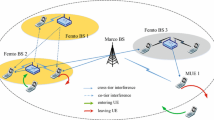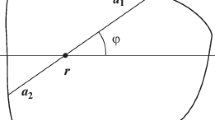Abstract
Multi-cell mobility model and performance analysis for wireless cellular networks are presented. The mobility model plays an important role in characterizing different mobility-related parameters such as handoff call arrival rate, blocking or dropping probability, and channel holding time. We present a novel tractable multi-cell mobility model for wireless cellular networks under the general assumptions that the cell dwell times induced by mobiles’ mobility and call holding times are modeled by using a general distribution instead of exponential distribution. We propose a novel generalized closed-form matrix formula to support the multi-cell mobility model and call holding time with general distributions. This allows us to develop a fixed point algorithm to compute loss probabilities, and handoff call arrival rate under the given assumptions. In order to reduce computational complexity of the fixed point algorithm, the channel holding time of each cell is down-modeled into an exponentially distributed one for purposes of simplification, since the service time is insensitive in computing loss probabilities of each cell due to Erlang insensitivity. The accuracy of the multi-cell analytic mobility model is supported by the comparison of the simulation results and the analytic ones.
Similar content being viewed by others
References
Mitchell, K., Sohraby, K., Liefvoort, A., & Place, J. (2000). Approximation models of wireless cellular networks using moment matching. In INFOCOM. Nineteenth annual joint conference of the IEEE computer and communications societies (Vol. 1, pp. 189–197). Tel Aviv, Israel.
Chiang K., Shenoy N. (2004) A 2-D rand-walk mobility model for location-management studies in wireless networks. IEEE Transactions on Vehicular Technology 53(2): 413–424
Mitchell, K., & Sohraby, K. (2001). An analysis of the effects of mobility on bandwidth allocation strategies in multi-class cellular wireless networks. In INFOCOM 2001. Twentieth annual joint conference of the IEEE computer and communications societies (Vol. 2, pp. 1005–1011). Anchorage, AK, USA.
Mitchell, K., & Sohraby, K. (2007). Modeling the effects of mobility on QoS in wireless multimedia networks. In Adaptation techniques in wireless multimedia networks (Chap. 12, pp. 285–306). Hauppauge, NY: Nova Science.
Hong D., Rappaport S.S. (1986) Traffic model and performance analysis for cellular mobile radio telephone systems with prioritized and nonprioritized handoff procedures. IEEE Transactions Vehicular Techonology 35(3): 38–58
Zonoozi M., Dassanayake P. (1997) User mobility modeling and characterization of mobility patterns. IEEE Journal on Selected Areas in Communications 15(7): 1239–1252
Akyildiz I., Ho J., Lin Y. (1996) Movement-based location update and selective paging for PCS network. IEEE/ACM Transactions on Networking 4(4): 629–638
Fang Y., Chlamtac I., Lin Y. (1998) Channel occupancy times and handoff rate for mobile computing and PCS networks. IEEE Transactions on Computers 47(6): 679–692
Ashtiani F., Salehi J.A., Aref M.R. (2003) Mobility modeling and analytical solution for spatial traffic distribution in wireless multimedia networks. IEEE Journal on Selected Areas in Communications 21(10): 1699–1709
Kleinrock L. (1975) Queueing systems: Theory. Wiley, New York
Orlik P., Rappaport S. (1998) A model for teletraffic performance and channel holding time characterization in wireless cellular communication with general session and dwell time distributions. IEEE Journal on Selected Areas in Communications 16(5): 788–803
Fang Y. (2001) Hyper-erlang distribution model and its application in wirelss mobile networks. Wireless Networks 7: 211–219
Gross D., Harris C. (1985) Fundamentals of queueing theory (Second Ed.). Wiley, New York
Vargas C., Hegde M.V., Naraghi-Pour M. (2004) Implied costs for multirate wireless networks. Wireless Networks 10(3): 323–337
Akl R., Hegde M., Naraghi-Pour M. (2005) Mobility-based CAC algorithm for arbitrary call-arrival rates in CDMA cellular systems. IEEE Transactions on Vehicular Technology 54(2): 639–651
Klimenok V., Kim C.S., Orlovsky D., Dudin A. (2005) Lack of invariant property of the erlang loss model in case of map input. Queneing Systems 49(2): 187–213
Beaubrun, R., Pierre, S., & Conan, J. (2004). Blocking probability analysis in future wireless networks. In 2004 IEEE international conference on communications (Vol. 4, pp. 2323–2326). Paris, France.
Lin Y., Chlamtac I. (1997) A model with generalized holding and cell residence times for evaluating handoff rates and channel occupancy times in PCS networks. International Journal of Wireless Information Networks 4(3): 163–171
Horn R.A., Johnson C.R. (1990) Matrix analysis. Cambridge University Press, Cambridge
Author information
Authors and Affiliations
Corresponding author
Rights and permissions
About this article
Cite this article
Kim, K., Choi, H. A Mobility Model and Performance Analysis in Wireless Cellular Network with General Distribution and Multi-Cell Model. Wireless Pers Commun 53, 179–198 (2010). https://doi.org/10.1007/s11277-009-9678-3
Received:
Accepted:
Published:
Issue Date:
DOI: https://doi.org/10.1007/s11277-009-9678-3




